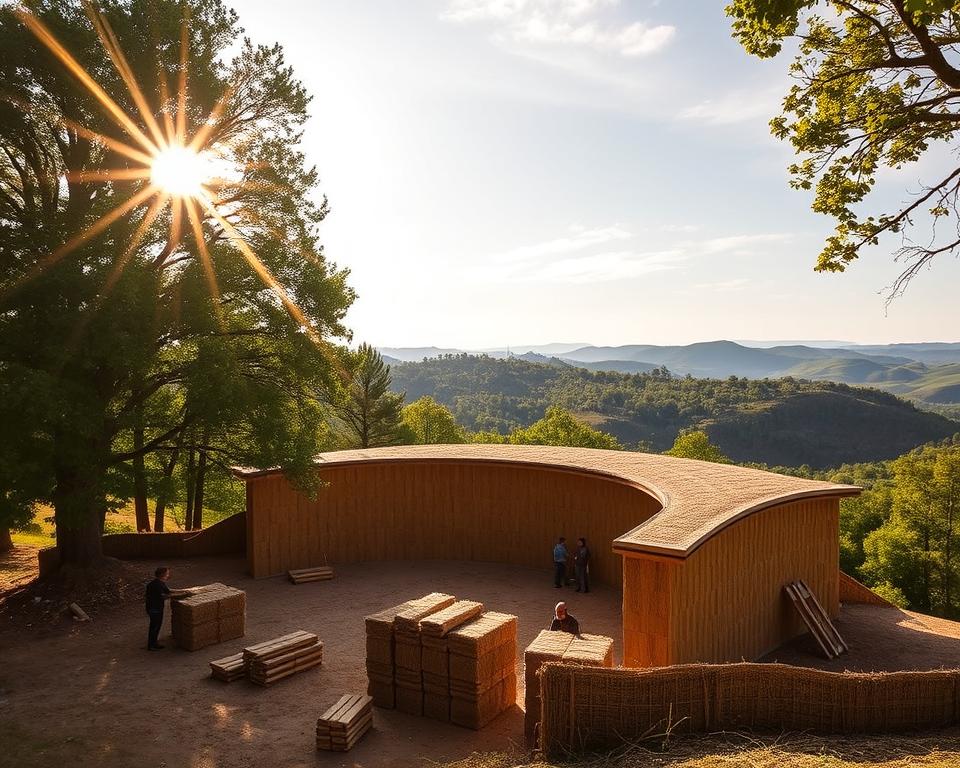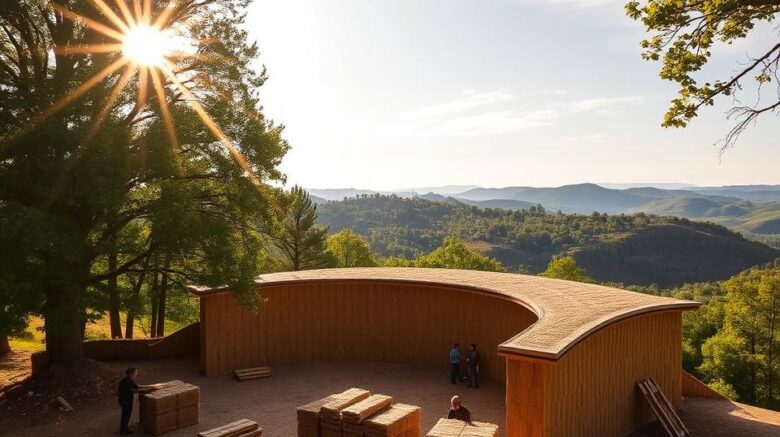Earth Bound Building: Straw-bale Construction in Laurel
Were you aware how houses built with sustainable building materials may cut energy costs by up to 50%? That’s one big reason why a growing number of homeowners choose eco-conscious design. Earth Bound Building, serving Laurel, leads this movement, focused on innovative and high-efficiency projects.
By using renewable materials like straw bales in timber frames, Earth Bound Building delivers home addition builders Laurel that remain not only planet-conscious and exceptionally durable. Their approach integrates time-honored craftsmanship with modern green practices, ensuring every project meets the top standards of sustainability.
Why Earth Bound Building stands out lies in their hands-on method and strong community involvement. They partner with homeowners to craft spaces that express their principles and needs. When you want a eco-conscious way to build, Earth Bound Building is your go-to partner in Laurel.
What is Straw-bale Construction?
Straw, sometimes treated as waste, is reshaping sustainable architecture. Straw bale construction uses stacking bales inside timber frames to build walls that are simultaneously highly insulating and structural. This method uses an agricultural byproduct, which makes it a sustainably sourced and low-impact choice.
Straw comes from grain crops such as wheat, rice, or barley. In place of burning or discarding it, farmers can sell it for construction. This reduces agricultural waste and provides a sustainable material for homes. The process is simple, making it ideal for owner-builders and community projects.
One of the standout features of straw bale walls is their insulation performance. Relative to traditional materials like fiberglass or wood, straw bales have a higher R-value. In practice, this means they retain heat better, resulting in lower energy costs. Below is a quick comparison:

| Material Type | R-Value (per inch) |
|---|---|
| Strawbale | R-2.38 |
| Fiberglass | R-2.20 |
| Wood | R-1.41 |
Another plus is the use of low-toxin materials. Straw bales are without harmful chemicals, supporting cleaner indoor air quality. That makes them a sound choice for families and eco-aware homeowners.
In summary, straw bale construction is a low-impact, power-saving, and wellness-minded option. It’s a strong choice for those aiming to reduce their environmental footprint while gaining long-term savings.
Why Select Earth Bound Building for Your Project?
Choosing the right team for your sustainable project matters greatly. Earth Bound Building is a front-runner in eco-friendly design, providing advanced solutions tailored to your needs. The firm’s approach combines state-of-the-art techniques with a genuine respect for the environment.
Commitment to Sustainability
Earth Bound Building emphasizes sustainable practices in every project. They use carbon-sequestering straw and low-embodied energy materials to reduce environmental impact. Beyond helping the planet but also supports long-term savings for homeowners.
Their relationships with regional farmers guarantee ethically sourced materials. By strengthening local agriculture, they build a circular economy. This commitment to sustainability sets them apart in the industry.
Local Expertise in Laurel
With strong connections in Laurel, Earth Bound Building knows the unique needs of the area. They are familiar with local climate conditions, permitting processes, and supply chains. This expertise delivers smooth project execution and compliance with regulations.
Their custom designs reflect Laurel’s aesthetic preferences while satisfying strict building codes. Whether it’s a residential or commercial project, they produce results that blend seamlessly with the local environment.
| Aspect | Earth Bound Building | Traditional Practices |
|---|---|---|
| Sourcing of Materials | Local, ethically sourced straw | Imported, high-embodied energy materials |
| Thermal Performance | High R-value insulation | Standard insulation |
| Environmental Impact | Low carbon footprint | Higher emissions |
Earth Bound Building’s commitment to sustainability and local expertise positions them as a top pick for your next project. Their progressive practices and community-driven approach provide a seamless and eco-friendly experience.
The Benefits of Strawbale Building Laurel
Sustainable architecture is growing rapidly for its ability to merge innovation with environmental responsibility. One of the most promising methods in this field is the use of straw bales. This approach delivers a range of benefits, from energy efficiency to eco-friendliness, which makes it an appealing option for modern homeowners.
Energy Efficiency and Cost Savings
Straw bale walls offer outstanding insulation, surpassing traditional materials such as fiberglass. With an R-value of 2.38 per inch, they balance indoor temperatures, lowering the need for heating and cooling. This can result in energy savings of up to 50-75%.
Over time, these savings can offset the initial construction costs. Homeowners benefit from lower energy bills while advancing a greener planet. Here is how straw bales stack up against other materials:
| Material | R-Value per inch |
|---|---|
| Straw Bale | R-2.38 |
| Fiberglass | R-2.20 |
| Wood | R-1.41 |
Eco-Friendly and Renewable
Straw is a renewable resource that is harvested every year, in contrast to timber, which requires decades to grow. Using straw in construction lowers agricultural waste and promotes a circular economy. It also traps CO₂ in the walls, helping to fight climate change.
Additionally, straw bale walls are free of toxic additives, supporting better indoor air quality. They are also highly fire safe, with plastered walls exceeding 2-hour fire ratings. This makes them a safe and responsible choice for any project.
By choosing straw bale construction, you’re building more than a house—you’re committing to a more wholesome, more sustainable future.
How Straw bale Homes Are Constructed
There are a few ways to create sustainable homes using straw bales. Each method offers unique benefits, from structural support to faster installation. Comparing these options can help you decide on the best approach for your project.
Nebraska Style vs. In-Fill Wall Systems
The Nebraska Style is a heritage method where straw-bale walls serve as the primary structural support. This approach is well-suited for smaller homes and focuses on simplicity. The bales are stacked directly on the foundation, eliminating the need for additional supports or frames.
In contrast, In-Fill Wall Systems use timber frames to take the structural load. The bales are installed within these frames, enabling faster roof installation and broader design flexibility. This method is popular for larger projects where customization is key.
Prefabricated Straw Wall Panels
Prefabricated panels are a next-gen innovation in straw bale construction. These factory-built panel sections reduce on-site work and lower weather-related risks. They are designed for quick assembly, thereby making them a practical choice for time-sensitive projects.
Here is a comparison of the three methods:
| Method | Key Features | Ideal For |
|---|---|---|
| Nebraska Style | Load-bearing bales, simple process | Small homes |
| In-Fill Systems | Timber frames, design flexibility | Larger projects |
| Prefabricated Panels | Factory-built, reduced on-site work | Quick installations |
Each method has its strengths, and the choice depends on your project’s needs. Whether you choose traditional techniques or modern innovations, straw bale construction delivers a sustainable and time-savvy solution.
Common Myths About Straw bale Construction
Many people hold myths around sustainable materials like straw. These myths frequently prevent homeowners from exploring eco-friendly options. Let’s clear up some of the most common concerns.
Fire Resistance and Safety
One of the biggest myths is that straw is a fire hazard. In reality, compressed bales do not have the oxygen needed to burn. Lab tests demonstrate that plastered straw walls can withstand 2+ hours of fire exposure. This outperforms the fire resistance of many traditional materials like wood.
Plaster acts as a protective barrier, enveloping the bales and inhibiting ignition. This renders straw-based structures very safe. Below is a quick comparison:
| Material Type | Fire Rating |
|---|---|
| Straw (plastered) | 2+ hours |
| Wood | 1 hour |
Pest and Moisture Management
Another concern is pests. Straw has zero nutritional value, making it unattractive to rodents and insects. When covered with plaster, it becomes very hard for pests to penetrate. This neutralizes one of the most common concerns homeowners worry about.
Moisture is also addressable with proper design. Elevated foundations, wide eaves, and breathable finishes like vapor-permeable stucco reduce the risk of rot. Modern techniques ensure these homes remain durable for decades.
Compare how straw compares to traditional materials in moisture control:
| Material | Moisture Resistance |
|---|---|
| Straw with Proper Design | High |
| Wood without Treatment | Low |
By addressing these myths, it’s clear that straw-based structures are a secure, eco-friendly, and enduring choice for modern homes.
Is a Straw-bale Home Right for You?
Planning a home that’s both appealing and sustainable is more attainable than you might expect. With unique features like recessed window niches and sweeping designs, eco-friendly homes provide endless possibilities. Consider why this might be the perfect choice for you.
Customization and Aesthetic Appeal
One of the signature features of these homes is their design flexibility. You can create sculptural walls, arched doorways, and built-in shelving to suit your style. The thick walls also provide excellent acoustic privacy, making your space peaceful and quiet.
Rustic plaster finishes bring a unique charm, merging modern aesthetics with natural elements. Whether you’re an artist or an eco-conscious family, these homes can be tailored to mirror your personality and needs.
Long-Term Benefits and Sustainability
Opting for a sustainable home isn’t just about the environment—it’s also a savvy financial decision. These homes have lower upkeep over time, thanks to their energy efficiency. With lower heating and cooling bills, you’ll see significant savings on utilities.
Additionally, green homes may be eligible for tax incentives and tend toward higher property values. Below is a quick comparison of lifecycle costs:
| Cost Area | Straw Bale Homes | Conventional Homes |
|---|---|---|
| Utilities | Lower | Higher |
| Maintenance | Minimal | Regular |
| Resale Value | Higher | Standard |
Earth Bound Building’s consultation process helps ensure your goals align with your budget. Whether you’re planning an off-grid retreat or a family home, they’ll work with you every step of the way.
In Summary
Adopting eco-friendly living begins with the right materials and the right team. Straw bale homes offer unmatched benefits, from energy efficiency to durability. They lower costs while helping the environment, making them a savvy choice for modern homeowners.
Earth Bound Building leads the way in green construction in Laurel. Their expertise ensures every project achieves the highest standards of quality and eco-friendliness. Join the growing community of homeowners who’ve chosen this modern approach.
Eager to begin? Contact Earth Bound Building for a tailored consultation. Attend their workshops or tour completed projects to see the benefits firsthand. Building with bale not only creates a residence but also strengthens regenerative agriculture and local economies.
